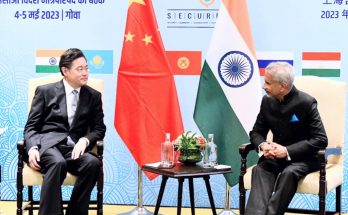 Cliches are self-perpetuating. How many times have we heard that India and China are ancient civilisations with their relations going back to the dawn of time? In official speeches, much is being made out of civilizational links between the two countries and references are often made to the cross-cultural intermingling that harks back a few centuries ago when Buddhism travelled from India and China through itinerant pilgrims and scholars. Yes, it’s true that India-China relations go back thousands of years, blurring history and myth. There are at least seven references to China in Mahabharata and more than 35,000 words of Sanskrit origin are said to have found their way into Mandarin. Historian Arthur Waley has speculated that the holy mountain man (Sheng-Hsien) described by the celebrated Taoist sage Lieh Tzu is an Indian sage in mystical trance. One can go on and on with such historical and literary allusions….
Cliches are self-perpetuating. How many times have we heard that India and China are ancient civilisations with their relations going back to the dawn of time? In official speeches, much is being made out of civilizational links between the two countries and references are often made to the cross-cultural intermingling that harks back a few centuries ago when Buddhism travelled from India and China through itinerant pilgrims and scholars. Yes, it’s true that India-China relations go back thousands of years, blurring history and myth. There are at least seven references to China in Mahabharata and more than 35,000 words of Sanskrit origin are said to have found their way into Mandarin. Historian Arthur Waley has speculated that the holy mountain man (Sheng-Hsien) described by the celebrated Taoist sage Lieh Tzu is an Indian sage in mystical trance. One can go on and on with such historical and literary allusions….
Cliches and Stereotypes
But one can’t subsist on the past, rich and varied it might be, for long. It’s time to move beyond feel-good clichés to ask some  straight questions. How much of this centuries-old civilizational interaction define the modern context of relations between the two rising Asian powers, which continues to be marred by a festering trust deficit, negative perception and a formulaic representation of each other despite a dramatic acceleration of economic ties in the last few years. Confucius, Calligraphy and Chinese food – this trinity pretty much conjures up Chinese culture for most of middle-class educated Indians. And then there is the picture of modern China, of shining new cities, high-speed trains, an authoritarian system with an exuberantly free market economy and a can-do Asian power that is aspiring to end the American Century. In China, too, a set of images define what most Chinese think of India. “A half-finished democracy, a harmonious co-existence between past and present, and Indians who are good at thinking” – this is what some journalism students from Shantou University, located in Guangdong, wrote in an article after their visit to India.
straight questions. How much of this centuries-old civilizational interaction define the modern context of relations between the two rising Asian powers, which continues to be marred by a festering trust deficit, negative perception and a formulaic representation of each other despite a dramatic acceleration of economic ties in the last few years. Confucius, Calligraphy and Chinese food – this trinity pretty much conjures up Chinese culture for most of middle-class educated Indians. And then there is the picture of modern China, of shining new cities, high-speed trains, an authoritarian system with an exuberantly free market economy and a can-do Asian power that is aspiring to end the American Century. In China, too, a set of images define what most Chinese think of India. “A half-finished democracy, a harmonious co-existence between past and present, and Indians who are good at thinking” – this is what some journalism students from Shantou University, located in Guangdong, wrote in an article after their visit to India.
India-China Media Forum
 These biases, set phrases and skewered half-baked perceptions have crept into the portrayal of India-China relations. In the media and commentariat, one finds a preponderance of two Cs – crisis and catastrophe. There is a potent temptation, fuelled by a chase for eyeballs, to project India and China as rivals and enemies. The incursion by Chinese troops in Ladakh nearly five months ago spawned a spate of critical commentaries in the Indian media, and revived the spectre of the China threat.
These biases, set phrases and skewered half-baked perceptions have crept into the portrayal of India-China relations. In the media and commentariat, one finds a preponderance of two Cs – crisis and catastrophe. There is a potent temptation, fuelled by a chase for eyeballs, to project India and China as rivals and enemies. The incursion by Chinese troops in Ladakh nearly five months ago spawned a spate of critical commentaries in the Indian media, and revived the spectre of the China threat.
 A recent survey by the Global Times, China’s influential daily, disclosed that apart from “China” and “India,” “border” is the most common word used in headlines of Indian media reports on China and has appeared in the headlines of 17.8 per cent of all reports. The survey also disclosed that 9.5 per cent of Indian media reports on China have a negative perspective while positive reporting on China only accounts for 4.2 per cent in the Indian media. The flip side of this statistical construct is that over 80 per cent of Indian media reports are neutral about China and contains elements of admiration and even envy about China’s rapid strides in eliminating poverty and spawning a hundred cities of high-rises bulging with aspirations of good living. On the other hand, the Chinese media is not only seen to be selective in reporting about India, but as the Global Times survey suggested there has been a dramatic decline in reports about India in leading Chinese media platforms. Against this backdrop, an important initiative is being taken and needs to be encouraged – leading Indian and Chinese journalists and opinion-makers of India and China held their first formal India-China Media Forum in New Delhi September 16 and mapped a multi-pronged strategy to enhance communication linkages and develop more nuanced perceptions of each other.
A recent survey by the Global Times, China’s influential daily, disclosed that apart from “China” and “India,” “border” is the most common word used in headlines of Indian media reports on China and has appeared in the headlines of 17.8 per cent of all reports. The survey also disclosed that 9.5 per cent of Indian media reports on China have a negative perspective while positive reporting on China only accounts for 4.2 per cent in the Indian media. The flip side of this statistical construct is that over 80 per cent of Indian media reports are neutral about China and contains elements of admiration and even envy about China’s rapid strides in eliminating poverty and spawning a hundred cities of high-rises bulging with aspirations of good living. On the other hand, the Chinese media is not only seen to be selective in reporting about India, but as the Global Times survey suggested there has been a dramatic decline in reports about India in leading Chinese media platforms. Against this backdrop, an important initiative is being taken and needs to be encouraged – leading Indian and Chinese journalists and opinion-makers of India and China held their first formal India-China Media Forum in New Delhi September 16 and mapped a multi-pronged strategy to enhance communication linkages and develop more nuanced perceptions of each other.
Two Cs: Culture and Creativity
This bridge-building and whetting the appetite to know more about each other shouldn’t be, however, a one-off affair, but a continuous process. It’s time to recall our credentials as ancient civilisations, which once accounted for a sizeable portion of global GDP and attracted the world with its myriad cultural accomplishments, and replace crisis and catastrophe with the two new Cs – Culture and Creativity. In other words, the two ancient civilisations have to move beyond mantra-chanting and make their cultural depth and richness the living context of their evolving relations in the 21st century.
 And the picture is not unremittingly bleak here. There is potentially a huge receptive audience in both countries for each other’s cultural attractions and cultural products. In this context, popular culture could be a powerful connector and bridge-builder between the two rising Asian powers which are interlinked by kindred value systems, in terms of respect for family traditions, the premium on education and cultivation of the mind.
And the picture is not unremittingly bleak here. There is potentially a huge receptive audience in both countries for each other’s cultural attractions and cultural products. In this context, popular culture could be a powerful connector and bridge-builder between the two rising Asian powers which are interlinked by kindred value systems, in terms of respect for family traditions, the premium on education and cultivation of the mind.
The power of films and performance arts truly transcends borders. Bollywood has done more for India-China relations than inspired rhetoric. Three Idiots, a film that exposes the ruthlessness of performance-oriented education system, has been a huge success in China. Everywhere you travel in China and talk to young people, and say that you are from India, they are sure to tell you something about Three Idiots which has struck a chord in the deeper recesses of the Chinese psyche. Similarly, Life of Pi, a film about an Indian orphan’s heroic survival after a  shipwreck with a Bengal tiger, was a smashing success in China and has done its bit in kindling interest among young Chinese about India. Pondicherry is now a desirable tourist destination for Chinese, thanks to Life of Pi. Sadly, Chinese films have not made that kind of impact in India. Yes, the kung fu/martial arts genre has its captive followers, and this was more than evident at the kind of crowds Jackie Chan attracted in India when he was here three months ago. Many Chinese can name at least three-four Indian film stars – Amitabh Bachchan, Amir Khan, Shah Rukh Khan and Aishwarya Rai have some recall value in China — but ask any Indian to name 3-4 Chinese top film stars and actors, most will draw a blank beyond Jackie Chan.
shipwreck with a Bengal tiger, was a smashing success in China and has done its bit in kindling interest among young Chinese about India. Pondicherry is now a desirable tourist destination for Chinese, thanks to Life of Pi. Sadly, Chinese films have not made that kind of impact in India. Yes, the kung fu/martial arts genre has its captive followers, and this was more than evident at the kind of crowds Jackie Chan attracted in India when he was here three months ago. Many Chinese can name at least three-four Indian film stars – Amitabh Bachchan, Amir Khan, Shah Rukh Khan and Aishwarya Rai have some recall value in China — but ask any Indian to name 3-4 Chinese top film stars and actors, most will draw a blank beyond Jackie Chan.
The film co-production agreement and film festivals could be a good way to leverage the power of cinema to burnish India-China relations. China is expected to be the guest country at next year’s India International Film Festival in Goa. China currently allows 10 Hollywood films to be screened every year. India is hoping that five Indian films are allowed to be shown in China every year.
Culture Industries
 Moving beyond films, there is also a lot that can be done in the field of music. While classical music and dance have their own charms – a performance by Bharatnatyam dancer Pratibha Prahlad in China garnered much appreciation – it’s time to raise the sights and look at more Indo-China collaborative enterprises in genres of music that resonate with the young. Jazz and rock and roll is perhaps the way to go, with many desi and Chinese rock groups creating a big splash.
Moving beyond films, there is also a lot that can be done in the field of music. While classical music and dance have their own charms – a performance by Bharatnatyam dancer Pratibha Prahlad in China garnered much appreciation – it’s time to raise the sights and look at more Indo-China collaborative enterprises in genres of music that resonate with the young. Jazz and rock and roll is perhaps the way to go, with many desi and Chinese rock groups creating a big splash.
Sadly, our cultural frame of reference remains Westward-looking and west-centric. Both Indians and Chinese know more about Hollywood film stars and Western cultural icons than about each other. The fact is that the American power has succeeded to the extent it has is not just because of its economy and military power, but in the enduring power of it cultural products and the sheer magnetism of its popular culture, which has been backed by a concerted marketing push.
The story of the India-US relations is instructive here: the transformation of the India-US relationship from estranged democracies to engaged democracies may have been spurred by a landmark nuclear deal, but the stage was set by multi-pronged popular contacts and the sense of mutual cultural attraction – over 100000 Indian students live in the US, Hollywood films and rock-and-roll are staple diet for Indians, nearly every middle class Indian family has some relative or other living in the US, and the American dream burns bright as ever in India. But this kind of people-to-people contact has yet to leaven the India-China relationship. If Indians and Chinese do not know enough about each other’s culture, what kind of Asian renaissance are we talking about?
More incursions – into mind
 Culture and creativity, by their nature, are blithely indifferent to borders as they connect us to the universal language of humanity and the human urge for transcendence through the power of expression. We have been obsessed with incursions – a carryover of the undefined border which the leaders and officials of the two countries are trying to resolve through painstaking negotiations – but we can perhaps do with more incursions in the realm of mind and spirit – into each other’s culture and creative enterprises.
Culture and creativity, by their nature, are blithely indifferent to borders as they connect us to the universal language of humanity and the human urge for transcendence through the power of expression. We have been obsessed with incursions – a carryover of the undefined border which the leaders and officials of the two countries are trying to resolve through painstaking negotiations – but we can perhaps do with more incursions in the realm of mind and spirit – into each other’s culture and creative enterprises.
The Power of Story-Telling
 Beyond the relentless chatter of 24×7 news and the insatiable quest for breaking-news blockbuster headlines, it’s time, therefore, to move into a deeper realm of communication – of aesthetics, the arts, music and literature. In fact, this kind of deeper cultural and aesthetic communication could be the best bulwark and long-term investment in building better and harmonious relations between the two ancient civilisations which are scripting their ascent up the global ladder. We have to tell more stories about each other, for stories — and not just the news stories — but stories about who we are and where we are in this place called Time. The language in which we choose to communicate will, therefore, be crucial in determining the contours of the India-China relationship in the next few decades of the 21st century. If we choose to speak of each other as enemy and rival, and persist in this habit, it may well turn out to be a self-fulfilling prophecy. By the way we talk about each other, we can transform our relationship and the world we live in.
Beyond the relentless chatter of 24×7 news and the insatiable quest for breaking-news blockbuster headlines, it’s time, therefore, to move into a deeper realm of communication – of aesthetics, the arts, music and literature. In fact, this kind of deeper cultural and aesthetic communication could be the best bulwark and long-term investment in building better and harmonious relations between the two ancient civilisations which are scripting their ascent up the global ladder. We have to tell more stories about each other, for stories — and not just the news stories — but stories about who we are and where we are in this place called Time. The language in which we choose to communicate will, therefore, be crucial in determining the contours of the India-China relationship in the next few decades of the 21st century. If we choose to speak of each other as enemy and rival, and persist in this habit, it may well turn out to be a self-fulfilling prophecy. By the way we talk about each other, we can transform our relationship and the world we live in.
(Manish Chand is Editor-in-Chief of India Writes, www.indiawrites.org, an online magazine and journal focused on international affairs, the India Story, emerging powers, China and Africa. He is also the founder of the China Connect initiative, which seeks to bridge knowledge and perception gap between India and China).
Author Profile

- Manish Chand is Founder-CEO and Editor-in-Chief of India Writes Network (www.indiawrites.org) and India and World, a pioneering magazine focused on international affairs. He is CEO/Director of TGII Media Private Limited, an India-based media, publishing, research and consultancy company.
Latest entries
 India and the WorldMarch 3, 2024India-Denmark Connect: Red carpet for Indians to Red Sea cooperation
India and the WorldMarch 3, 2024India-Denmark Connect: Red carpet for Indians to Red Sea cooperation India and the WorldFebruary 17, 2024Munich Security Conference: Jaishankar, Blinken focus on Red Sea, Middle East
India and the WorldFebruary 17, 2024Munich Security Conference: Jaishankar, Blinken focus on Red Sea, Middle East India and the WorldFebruary 14, 2024Munich Security Conference report: Migration, war top security threats
India and the WorldFebruary 14, 2024Munich Security Conference report: Migration, war top security threats India and the WorldJanuary 23, 2024With “Ram to Rashtra” mantra, Modi consecrates Ram temple for national renewal
India and the WorldJanuary 23, 2024With “Ram to Rashtra” mantra, Modi consecrates Ram temple for national renewal







